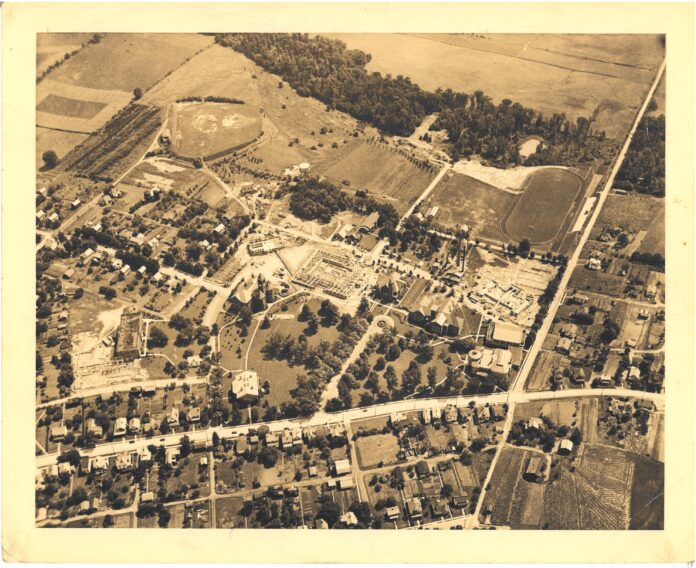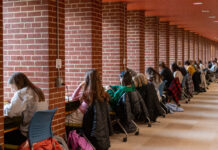
Forgotten mining tunnels have been lying beneath the surface of SRU since their usage stopped in the 1950s. This fact is unbeknownst to most of the Slippery Rock community due to a lack of documentation.
The entrance to the mine is now sealed, according to SRU historian Robert Watson.
Watson, who wrote the book “Slippery Rock University: The Legend Behind the Name”, provided The Rocket with documents that reveal the location of several mining amenities.
“We don’t have good pictures to document everything,” he said. “But I do have enough pictures that will let you know this actually happened.”
The drainage pond
In an aerial photograph from approximately 1939, an acid drainage pond can be seen in what is now the quad. There were no buildings in that area at the time.
“That would have been highly acidic, because of the mine dig and the acid mine drainage coming out of that hillside. And I don’t know a single coal mine in Pennsylvania that would not have acid mine drainage coming out of it,” Watson said.
Based on other buildings in the photo, one can see the pond sits between Spotts World Cultural Building and the Advanced Technology and Science (ATS) building.
“[Spotts] sits, at least in part, on top of a settling pond,” Watson said. “Where the sludge would be…is right in here. The corners of ATS and the back corner of Spotts.”
Watson believes they filled the pond when Spotts was built.
The opening
In the same aerial photograph, a pile of leftover rock and gravel from inside the mines is present. These piles of “refuse slag” are referred to as bony piles.
The location of the bony pile falls very close to what is now the Physical Therapy (PT) building in the quad.
“Bony piles were very close to the mouth of mines because you didn’t want to haul that stuff any further than you have to,” Watson said, “so the mouth of the original mine has to be somewhere around this southwest corner of PT.”
Patrick Burkhart, who has been a geology professor at SRU for 27 years, said he heard rumors about where the opening could be.
“On the way down that hill [from the student center to the field house] on the right hand side, 30 feet off the roadway in some trees is a concrete box with a steel manhole,” Burkhart said. “I’ve always heard that the portal to the mine is down in that vault.”
Director of Facilities Scott Albert said the mines may be further up the hill.
“The research for the Police/ROTC building showed that the coal mine appears to be north of the Smith Center,” he said. “While I am not aware of an entrance between Spotts/PT that doesn’t mean there wasn’t one there in the past.”
The tunnels
Somewhere out there exists a map of the tunnels. However, it was given to a previous director of facilities who has since passed away.
“It is probably in a storage unit, collecting dust somewhere,” Watson said.
It is now uncertain where exactly the tunnels are or when they were abandoned. The end date was somewhere in the 1950s and may be marked in notes from a Council of Trustees meeting.
Watson estimated the location based on his memory of the map and eyewitness accounts.
“I describe [the tunnels] like fingers going into the hillside,” Watson said. “You wanted to build your shafts as close as possible…because [if not], you missed all the coal in the middle…if you built the shafts too close together, they would collapse. You had to separate them a little bit.”
There should be four “fingers” that are not far below the surface.
“The mine shafts were as deep as the coal was. They didn’t dig any more shallow or any deeper than they had to, they stayed with the seam of coal. If the seam moved this way, the shaft moved this way.”
On top of these tunnels was a dormitory next to what is now the student center. The building was eventually turned into a parking lot for reasons unrelated to the mines.
The history
At a time when SRU produced all its own food, it supplied its own power and heat as well.
“That coal mine…at one point in time it produced all of the coal for the heating of every building on campus,” Watson said. “It began as the campus grew.”
Watson claimed to know Harry Horseman, who is allegedly one of the last men to ever mine coal at SRU. Horseman told Watson about the mining process itself.
“We had a guy leading a Shetland pony and a cart,” Watson said, “and Harry Horseman dug coal with a pick and shovel.”
Several factors led to the mines’ creation. One of them is the resource-rich geology of the area.
“This whole area is filled with limestone, gravel and coal. And that was all because of the geological nature of the Slippery Rock Creek area, which that creek largely was developed by a large glacier that moved down from Canada,” Watson said.
According to Burkhart, historical factors were also at play. “I had heard that the mining was done during World War II,” he said.
“Coal is in short supply. Coal is used to manufacture steel and produce heat, and all of that has gone into the war. So, the university turns to mining its own coal,” Burkhart said. “In the 20th century in Pennsylvania, coal was king.”
The impact
Though they are no longer in use, the presence of the mines continues to affect operations on campus.
Recently, the university canceled plans to build a new ROTC and police station building due to funds.
“One of the factors that contributed to these increased costs is the risk mitigation work that would have been required to build on top of the underground mine. To construct the new building on top of the mine tunnels would have required grouting the mine tunnels to ensure the ground underneath the building would be strong enough to support the building’s weight,” Director of Facilities Scott Albert said.
Additionally, several buildings in the quad have dealt with structural issues over the years.
Watson shared an anecdote about a crack in either ATS or Spotts that was large enough to show daylight. “Well, the building’s not that old. It shouldn’t have a crack…but it’s built on top of a settling pond and mine.”
He told a story about the construction of the residential suites. Allegedly, a bulldozer was breaching the hillside when it hit a mineshaft.
According to him, “What has been built here, on top of some mine shafts, there’s a lot.”
Albert, who has worked in SRU facilities for 17 years, said there are no mines below existing campus buildings.
“Other tunnels that exist beneath campus grounds do not pose a threat to the health and safety of people above ground,” Albert said. “All of the recent structural work conducted on SRU buildings is unrelated to any underground mines.”
“I don’t think they affect us a great deal until you disturb them,” Watson said, “a good question might be, to what level of disturbance would you have to have before we start seeing the effects?”
Burkhart concurred that the mines will likely remain stable. “Honestly, I think layers of coal were so thin. The distance of rock above ground now is more than able to support the voids that may still remain.”
“It’s been 75 years, give or take some months, since the mining was over with…if it was going to [pose safety issues] it would have long ago,” he said.
The tunnels need a place to drain to this day, but this probably does not pose a threat either. Burkhart said no acid drainage has been spotted in recent years.
“We have a rock unit under campus called vanport limestone, and that rock will neutralize acidity…either there’s not acid drainage being generated in those mines, or it’s being naturally remediated,” he said.
This means that the mines do not directly hurt the quality of Slippery Rock water. However, it is affected by coal.
The Rocket plans to investigate this relationship further in a future article.
The unknown
This information is buried to students and professors alike.
“There’s people looking, I can tell you facilities is asking questions. I can tell you the president’s asking questions,” Watson said.
When The Rocket asked a different geology professor for comment, she stated that she was unaware of any mines.
Information on the topic differs across departments and even within them. This includes administrative bodies like facilities.
“We did a feasibility study related to some proposed work to the PT Building a couple of years ago…nothing about coal mines was noted on the drawings,” Albert said. “I would have to surmise the tunnel was filled in.”
Watson cites a lack of passion and documentation, stating, “The problem is we had a president who didn’t value the history of this place.”
“The only reason you’d know much about this if you start digging into the history,” he said. “We would not ever suspect that there is something under the ground there.”







